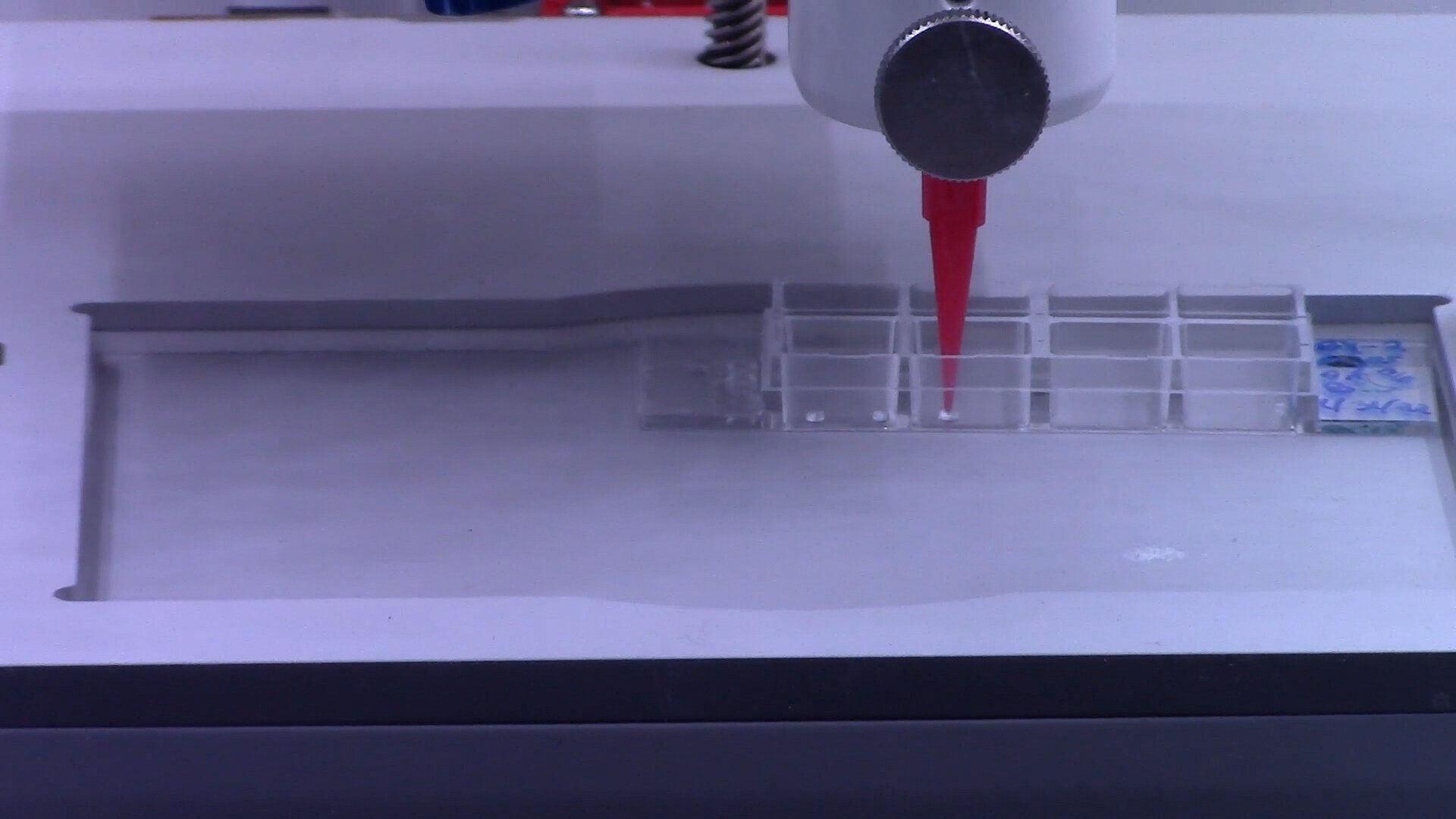Plant cells are bioprinted by a 3D printer, which has some necessary tweaks. Credit: Lisa Van den Broeck, NC State University
A new study from North Carolina State University shows a reproducible way to study cellular communication between different types of plant cells by “bioprinting” those cells via a 3D printer. Learning more about how plant cells communicate with each other – and with their environment – is key to better understanding plant cell functions and could ultimately lead to the creation of better plant varieties and optimal growing environments.
The researchers bioprinted cells from the model plant Arabidopsis thaliana and from soybeans to study not only whether plant cells would live after bioprinting – and for how long – but also to study how they acquire and change their identity and function.
“A plant root has many different cell types with specialized functions,” said Lisa Van den Broeck, an NC State postdoctoral researcher who is the first author of a paper describing the work. “Different sets of genes are also expressed; some are cell specific. We wanted to know what happens after you bioprint living cells and put them in an environment you designed: are they alive and doing what they are supposed to do?”
The process of 3D bioprinting plant cells is mechanically similar to printing ink or plastics, with a few necessary adjustments.
“Instead of 3D printing ink or plastic, we use ‘bioink’ or living plant cells,” said Van den Broeck. “The mechanics are the same for both processes, with some notable differences for plant cells: a UV filter used to keep the environment sterile, and multiple print heads – instead of just one – to print different bio-inks at the same time.”
Living plant cells without cell walls or protoplasts were bioprinted along with nutrients, growth hormones and a thickening agent called agarose – an algae-based compound. Agarose helps provide strength and scaffolding to the cells, much like mortar supports bricks in the wall of a building.
“We found that using appropriate scaffolding was critical,” said Ross Sozzani, professor of plant and microbial biology at NC State and co-corresponding author on the paper. “When you print the bio-ink it has to be liquid, but when it comes out it has to be solid. Mimicking the natural environment helps cellular signaling and signals occur as they do in soil.”
The research showed that more than half of the 3D bioprinted cells were viable and divided over time to form microcalli, or small colonies of cells.
“We expected good viability the day the cells were bioprinted, but we had never maintained the cells for more than a few hours after bioprinting, so we had no idea what would happen days later,” said Van den Broeck . “Similar viability ranges are seen after manually pipetting cells, so the 3D printing process does not appear to harm the cells.”
“This is a manually difficult process, and 3D bioprinting controls the printing of the droplets and the speed at which the droplets are printed,” Sozzani said. “Bioprinting offers better opportunities for high-throughput processing and control over the architecture of cells after bioprinting, such as layers or honeycomb shapes.”
The researchers also bioprinted individual cells to test whether they can regenerate or divide and multiply. Results showed that Arabidopsis root and shoot cells required different combinations of nutrients and scaffolds for optimal viability.
Meanwhile, more than 40% of the single soybean embryo cells remained viable two weeks after bioprinting and also divided over time to form microcalli.
“This shows that 3D bioprinting can be useful to study cell regeneration in crops,” Sozzani said.
Finally, the researchers examined the cellular identity of the bioprinted cells. Arabidopsis root cells and embryonic soybean cells are known for high proliferation rates and lack of fixed identities. In other words, these cells can become different cell types like animal or human stem cells.
“We found that bioprinted cells can assume the identity of stem cells; they divide and grow and express specific genes,” said Van den Broeck. “In bioprinting, you print an entire population of cell types. We were able to study the genes expressed by individual cells after 3D bioprinting to understand changes in cell identity.”
Researchers plan to continue their work on studying cellular communication after 3D bioprinting, including at the single-cell level.
“All in all, this study demonstrates the strong potential of 3D bioprinting for identifying the optimal compounds needed to support plant cell viability and communication in a controlled environment,” said Sozzani.
The research appears in scientific advances. Tim Horn, an assistant professor of mechanical and aerospace engineering at NC State, is a co-corresponding author on the article.
Bigger and more lifelike: What future do bioprinted organs have?
Lisa Van den Broeck et al, Establishing a reproducible approach to study cellular functions of plant cells using 3D bioprinting, scientific advances (2022). DOI: 10.1126/sciadv.abp9906. www.science.org/doi/10.1126/sciadv.abp9906
Provided by North Carolina State University
Citation: 3D Printing Plant Cells Shows Promise for Studying Cell Function (2022, October 14), retrieved October 14, 2022 from https://phys.org/news/2022-10-3d-cells-cell-function.html
This document is protected by copyright. Except for fair trade for the purpose of private study or research, no part may be reproduced without written permission. The content is for informational purposes only.
#printing #plant #cells #shows #promise #studying #cell #function


Leave a Comment